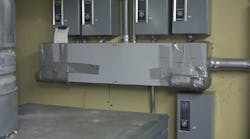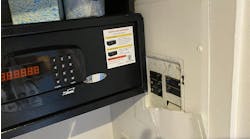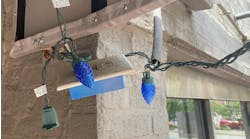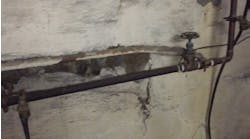As usual, never consider the following commentary associated with these photos as a formal interpretation of the National Electrical Code (NEC). Without criticizing anyone or any product, the following scenarios present us with serious safety questions.
YET ANOTHER USE FOR DUCT TAPE
Brian Wyllie, P.E., electrical project manager, Commercial Construction Consulting, Inc., Cambridge, Mass., recently found this somewhat sticky installation in a local hotel.Besides the fact that duct tape isn't listed or approved for electrical installations, the lack of proper working space in front of this equipment violates the requirements of 110.26, which state that sufficient access and working space must be provided and maintained around all electric equipment to permit ready and safe operation and maintenance. More specifically, the requirements of 110.26(A)(1) state, “The depth of the working space in the direction of live parts shall not be less than that specified in Table 110.26(A)(1) unless the requirements of 110.26(A)(1)(a), (b), or (c) are met. Distances shall be measured from the exposed live parts or from the enclosure or opening if the live parts are enclosed.” As this photo shows, the required 3 ft of clear distance in front of this equipment isn't available.
DOESN'T ANYONE READ THE INSTRUCTIONS?
Daniel Bala, project manager, Accord Electric, Huntington Beach, Calif., told the installers of this transformer they should have taken a little time to read the instructions for this unit, which read as follows: “All field wiring is required to be located in the wiring compartment below the level of the terminals. All field wiring connections are required to be made with UL Listed wire connectors that are suitable for the size and material of copper or aluminum wire involved. Conduit openings are required to be installed in the terminal compartment area only” (italics added). As you can see in this photo, the raceways feed directly into the top of the transformer — a clear violation of the instructions provided by the manufacturer. This installation also violates the requirements of 110.3(B).
JUST HIDE IT BEHIND A CHAIR
Bob Hill, a telecommunications electrical engineer in southern California, ran across this installation in a Spokane, Wash., hotel room while attending a seminar on power line RF interference last summer. This receptacle outlet was used as a supply for a wall-mounted air conditioning unit. The cover plate was secured with one very loose screw. The requirements of Art. 314 and Art. 406 were clearly overlooked in this installation. In addition, as noted in 440.65, “Single-phase cord-and-plug-connected room air conditioners shall be provided with factory-installed LCDI or AFCI protection. The LCDI or AFCI protection shall be an integral part of the attachment plug or be located in the power supply cord within 300 mm (12 in.) of the attachment plug.” No protection device was found.
PROTECTION FROM PHYSICAL DAMAGE
These feeders are located near a parking lot just off a street and alleyway. Notice how the service conductors in this installation are clearly subject to “physical damage.” The rules for protecting these conductors can be found in Art. 338, Part II, Sec. 338.10(B)(4)(b). The requirements in this section of the Code note that service-entrance conductors installed above ground must be protected against physical damage as specified in 230.50(A) or (B). Per 230.50(A), “Service cables, where subject to physical damage, shall be protected by any of the following:
-
Rigid metal conduit
-
Intermediate metal conduit
-
Schedule 80 rigid nonmetallic conduit
-
Electrical metallic tubing
-
Other approved means.”
Found a Code violation? Send your photos to Joe Tedesco at 350 North St., Boston, MA 02113 or [email protected].



